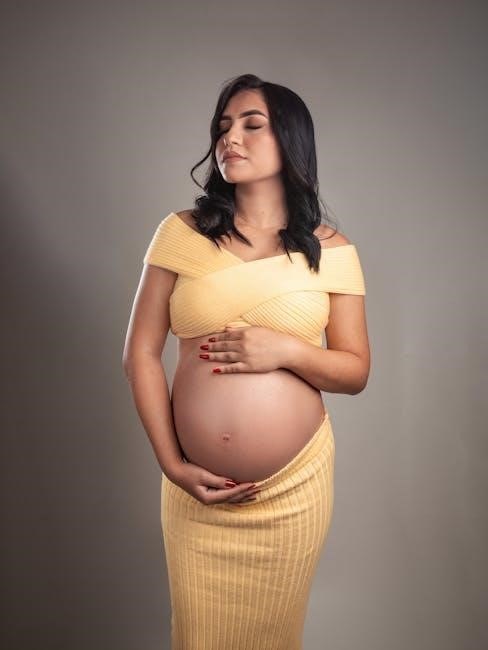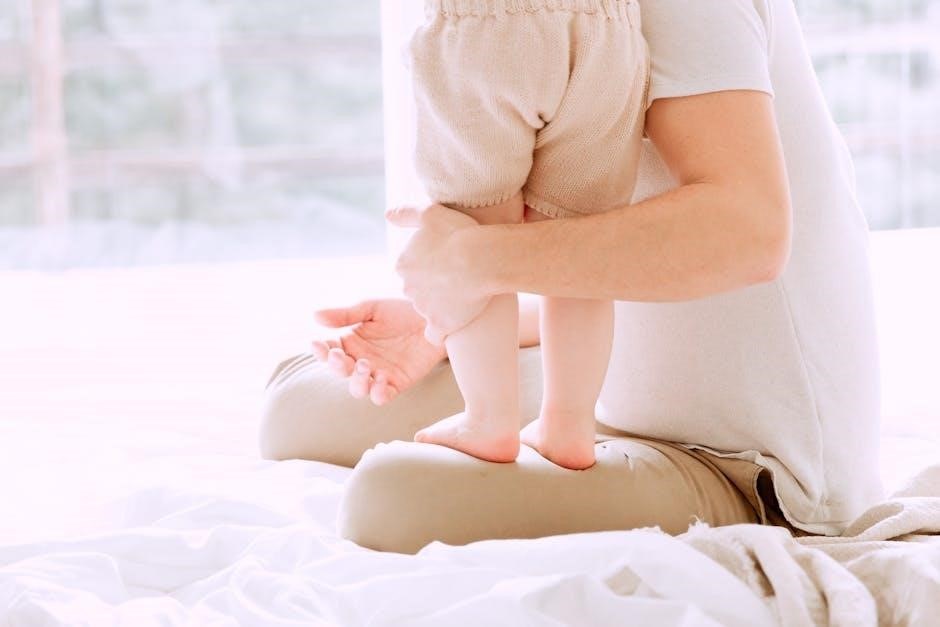The Love to Dream Temperature Guide Australia provides expert advice on dressing babies safely and comfortably based on room temperature, ensuring optimal sleep and reducing SIDS risks.
Understanding TOG Ratings
TOG (Thermal Overall Grade) measures fabric insulation, helping parents choose sleepwear based on room temperature to prevent overheating and ensure comfort, aligning with the Love to Dream guide.
What is TOG and Its Importance
TOG (Thermal Overall Grade) measures fabric insulation, indicating how much warmth a material provides. It helps parents select appropriate sleepwear for their baby’s room temperature, preventing overheating and ensuring comfort. Higher TOG ratings mean more insulation, suitable for colder rooms, while lower ratings are ideal for warmer environments. Understanding TOG is crucial for maintaining a safe sleep environment and reducing the risk of SIDS, as recommended by the Love to Dream guide.
How TOG Ratings Are Measured
TOG ratings are determined by measuring the thermal resistance of fabrics, assessing how well they retain warmth. The process involves testing the material’s ability to insulate against heat loss in controlled conditions. Love to Dream uses standardized methods to assign TOG values, ensuring accuracy and reliability. This measurement system helps parents choose sleepwear that matches their baby’s needs, promoting comfort and safety across various temperatures and climates in Australia.

Temperature Guide for Australia
The Love to Dream Temperature Guide offers tailored solutions for Australian climates, providing TOG ratings from 0.2 to 3.5 to suit varying room temperatures and seasonal needs.
0.2 TOG: Ideal for Warm Temperatures (24°C ౼ 27°C)
The 0.2 TOG rating is perfect for warm Australian climates, offering lightweight insulation for room temperatures between 24°C and 27°C. This TOG level ensures your baby stays cool and comfortable without overheating, reducing the risk of SIDS. Ideal for summer months, it provides just enough warmth while allowing natural temperature regulation. Parents can dress their baby in a nappy and a lightweight sleep suit or swaddle, ensuring a safe and restful sleep environment.
1.0 TOG: Suitable for Moderate Temperatures (20°C ౼ 24°C)
The 1.0 TOG rating is designed for moderate temperatures, making it ideal for rooms between 20°C and 24°C. This level provides a balanced warmth, ensuring your baby stays comfortable without overheating. It’s perfect for spring and autumn in Australia, offering just the right amount of insulation. Parents can layer a lightweight onesie under a 1.0 TOG sleep suit or swaddle, creating a safe and cozy sleep environment that promotes restful nights and reduces the risk of SIDS.
2.5 TOG: Best for Cooler Rooms (16°C ౼ 20°C)
The 2.5 TOG rating is perfect for cooler rooms, offering extra warmth without overheating. Ideal for temperatures between 16°C and 20°C, it’s a great choice for autumn and spring nights or air-conditioned spaces. Layer a mid-weight onesie under a 2.5 TOG sleep suit or swaddle to ensure your baby stays snug and comfortable. This TOG level strikes the right balance, providing insulation while maintaining breathability, ensuring a safe and restful sleep environment for your little one.
3.5 TOG: Recommended for Cold Temperatures (Below 16°C)
The 3.5 TOG rating is designed for colder environments, below 16°C, offering maximum warmth and insulation. Ideal for winter months or extremely cold rooms, this TOG level ensures your baby stays cozy without overheating. Pair a thick, warm onesie with a 3.5 TOG sleep suit or swaddle for optimal comfort. This rating is perfect for colder climates in Australia, providing the necessary warmth while maintaining breathability. Always check for signs of overheating to ensure a safe sleep environment;
Regional Climate Variations in Australia
Australia’s diverse climate ranges from tropical north to temperate south and arid center, requiring tailored approaches to baby sleepwear. This guide helps parents adapt to these variations effectively.
Adapting to Northern Australia’s Tropical Climate
Northern Australia’s tropical climate demands lightweight sleepwear to maintain comfort. For temperatures between 24°C and 27°C, the 0.2 TOG rating is ideal, offering breathability and preventing overheating. Parents should opt for moisture-wicking fabrics to keep babies cool. Ensuring the baby’s head remains uncovered is crucial, as hats or hooded clothing can trap heat. This approach aligns with reducing SIDS risks while promoting restful sleep in warm conditions. The Love to Dream guide provides tailored solutions for these regions, ensuring safety and comfort year-round.

Managing Southern Australia’s Temperate Climate
Southern Australia’s temperate climate requires versatile sleepwear solutions. For moderate temperatures between 20°C and 24°C, the 1.0 TOG rating is recommended, providing optimal warmth without overheating. During cooler months, layering with 2.5 TOG sleepwear ensures comfort. Parents should monitor room temperatures and adjust clothing accordingly, ensuring the baby’s environment remains safe and comfortable. The Love to Dream guide offers practical advice for adapting to these conditions, helping parents maintain their baby’s comfort and safety throughout the year.

Accommodating Central Australia’s Arid Conditions
Central Australia’s arid climate presents unique challenges, with extreme temperature fluctuations. For warmer days, opt for lightweight 0.2 TOG sleepwear, while cooler nights may require 2.5 or 3.5 TOG options. The Love to Dream guide recommends layering breathable fabrics during the day and adding warmth at night. Ensure your baby’s head remains uncovered to prevent overheating. This approach ensures comfort and safety, adapting to the region’s dry and variable conditions year-round.

Safety Tips for Dressing Your Baby
Prevent overheating by ensuring your baby’s head is uncovered and avoiding excessive layers. Check for warmth by feeling their chest or back of the neck, ensuring comfort and safety.
Preventing Overheating and Reducing SIDS Risk
Preventing overheating is crucial for reducing the risk of SIDS. Dress your baby in lightweight, breathable fabrics and avoid over-layering. Ensure their head and face remain uncovered, and check their temperature regularly by feeling their chest or the back of their neck. Use TOG-rated sleepwear appropriate for the room temperature, and maintain a safe sleep environment with a firm mattress and tight-fitting sheets. Monitor for signs of overheating, such as sweating or flushed skin, and adjust their clothing as needed to ensure comfort and safety.
Signs of Overheating and How to Respond

Signs of overheating include sweating, flushed skin, and rapid breathing. If you notice these, immediately remove excess layers and ensure your baby’s head and face are uncovered. Check the room temperature and adjust their sleepwear according to the TOG rating guide. Ensure good airflow in the room and avoid using thick blankets or bedding. Monitor your baby’s comfort closely and consult a healthcare professional if concerns persist. Responding promptly helps maintain a safe and comfortable sleep environment.

Dressing Your Baby for Sleep
Dressing your baby for sleep involves layering clothing according to TOG ratings, ensuring comfort and safety. Choose sleepwear based on room temperature for optimal rest and security.
Layering Clothing According to TOG Ratings
Layering clothing according to TOG ratings ensures your baby stays comfortable and safe. Start with a lightweight base layer, then add sleepwear with the appropriate TOG for the room temperature. For example, in warmer rooms (24°C-27°C), use a 0.2 TOG suit. In cooler rooms (16°C-20°C), opt for a 2.5 TOG, and below 16°C, choose a 3.5 TOG. This method prevents overheating and maintains a stable body temperature, promoting restful sleep and reducing the risk of SIDS. Always check your baby’s chest or back of the neck to ensure they feel warm but not hot, and avoid over bundling. Remember, higher TOG ratings mean more insulation, so select sleepwear that matches your room’s temperature for the best results. This layered approach helps create a safe and cozy sleep environment tailored to your baby’s needs.
Choosing the Right Sleepwear for Each Season
Seasonal sleepwear selection is crucial for your baby’s comfort and safety. In summer, opt for lightweight, breathable fabrics with a 0.2 TOG rating for temperatures above 24°C. For autumn and spring, 1.0 TOG sleepwear is ideal, offering moderate warmth for 20°C-24°C. Winter requires thicker, insulated options like 2.5 TOG or 3.5 TOG for temperatures below 16°C. Always choose sleepwear that aligns with the room temperature and your baby’s needs, ensuring comfort and preventing overheating. This seasonal approach ensures your baby sleeps safely and soundly year-round.
Checking Your Baby’s Temperature
Check your baby’s temperature by feeling their chest or back of the neck. Ensure their head is uncovered to prevent overheating and promote safe sleep conditions.
Physical Checks for Optimal Comfort
Regularly check your baby’s temperature by gently feeling their chest or the back of their neck. These areas should feel warm but not hot. Ensure their head remains uncovered to prevent overheating, as this is a key factor in reducing SIDS risk. Avoid using hats, bonnets, or hooded clothing during sleep. If your baby’s hands and feet feel cool, this is normal and not a cause for concern. Use these physical checks alongside the Love to Dream TOG guide to ensure your baby’s comfort and safety year-round.
Ensuring a Safe Sleep Environment
Creating a safe sleep environment involves maintaining an ideal room temperature and using appropriate bedding. Ensure your baby’s head is uncovered, avoiding hats, bonnets, or hooded clothing. Use breathable fabrics and avoid over-bedding to prevent overheating. Regularly check the room temperature and adjust sleepwear according to the Love to Dream TOG guide. A safe sleep environment not only promotes comfort but also reduces the risk of SIDS, ensuring your baby sleeps soundly and safely throughout the night.

Seasonal Sleepwear Guidance
The Love to Dream guide offers tailored sleepwear solutions for each season, ensuring your baby’s comfort. Lightweight, breathable fabrics for summer, thermal options for winter, and versatile layering for autumn and spring provide year-round adaptability, aligning with Australia’s diverse climates and TOG ratings for optimal safety and comfort.
Summer: Lightweight and Breathable Fabrics
For summer, the Love to Dream guide recommends using lightweight and breathable fabrics to keep your baby cool and comfortable. The 0.2 TOG rating is ideal for warm temperatures (24°C ౼ 27°C), offering minimal insulation while preventing overheating. Opt for sleepwear made from natural fibers like cotton, which allow airflow and moisture-wicking properties. These designs ensure your baby stays cool without compromising safety. Dressing your baby in a lightweight onesie under a 0.2 TOG sleep bag is perfect for summer nights, aligning with the guide’s recommendations for comfort and safety.
Winter: Thermal and Insulated Sleepwear
For colder months, the Love to Dream guide suggests using thermal and insulated sleepwear with a 3.5 TOG rating, ideal for temperatures below 16°C. These designs provide maximum warmth and comfort, ensuring your baby stays cozy without overheating. Look for sleepwear made from soft, breathable fabrics that trap warmth while allowing moisture to escape. Layering a thin onesie under a 3.5 TOG sleep bag is recommended for optimal comfort. This approach aligns with the guide’s expert advice for safe and comfortable winter sleep solutions.

Autumn and Spring: Versatile Layering Options
During autumn and spring, when temperatures are mild, the Love to Dream guide recommends using versatile layering options to adapt to fluctuating conditions. Opt for sleepwear with a 1.0 to 2.5 TOG rating, which provides balanced warmth without overheating. Layering a lightweight onesie under a TOG-rated sleep bag allows for easy adjustments as temperatures change. This approach ensures your baby remains comfortable and safe, aligning with the guide’s focus on seasonal adaptability and breathability to prevent overheating risks.

The Importance of the Love to Dream Guide
The Love to Dream guide is essential for Australian parents, offering expert advice to ensure baby’s comfort, safety, and optimal sleep quality year-round.
Why Australian Parents Should Use This Guide
The Love to Dream Temperature Guide is tailored for Australian climates, offering region-specific advice to ensure baby’s safety and comfort. It helps prevent overheating, linked to SIDS, by providing clear TOG-rated sleepwear recommendations. With varying temperatures across the country, this guide adapts to tropical, temperate, and arid conditions, ensuring optimal sleep quality. Its expert-backed insights empower parents to make informed decisions, fostering a secure and comfortable sleep environment year-round.
Expert Advice for Year-Round Comfort and Safety
The Love to Dream guide offers expert advice for dressing babies safely across all seasons. It provides TOG-rated sleepwear recommendations, ensuring optimal comfort and reducing SIDS risks. By adapting to Australia’s diverse climates, the guide helps parents choose the right sleepwear for any temperature, from tropical heat to cold winters. Its clear, region-specific guidance ensures babies stay comfortable and secure, promoting restful sleep and peace of mind for parents throughout the year.
Troubleshooting Common Issues
- Address discomfort by adjusting TOG ratings according to room temperature;
- Solve sleep disturbances by ensuring proper layering and fabric breathability.
Addressing Discomfort Due to Incorrect TOG
Incorrect TOG ratings can cause discomfort, disrupting your baby’s sleep. If your baby feels too hot or cold, adjust their sleepwear according to the room temperature. Check for signs of overheating, such as a hot chest or sweaty neck, and remove layers if necessary. For cooler rooms, add a higher TOG-rated item. Always ensure the sleep environment is safe and well-ventilated. Using a room thermometer and following the Love to Dream guide can help prevent discomfort and ensure optimal sleep conditions year-round.
Solving Sleep Disturbances Related to Temperature
Sleep disturbances due to temperature can be resolved by ensuring your baby’s environment is comfortable. Monitor room temperature and adjust sleepwear according to TOG ratings. Use a room thermometer to maintain an ideal range. Check for signs of overheating, such as a hot chest or sweaty neck, and adjust layers as needed. Ensure the sleep area is well-ventilated and free from drafts. The Love to Dream guide offers expert advice to help maintain optimal comfort and safety, promoting restful sleep for your baby.
The Love to Dream Temperature Guide Australia ensures your baby’s comfort and safety by providing expert advice on dressing according to room temperature, promoting peaceful sleep year-round.
Final Thoughts on Using the Love to Dream Guide
The Love to Dream Temperature Guide Australia is an essential tool for parents, offering expert advice to ensure their baby’s comfort and safety. By understanding TOG ratings and adapting to regional climates, parents can create a sleep environment that promotes restful nights. This guide is tailored to Australia’s diverse weather conditions, helping you choose the right sleepwear for any season; Prioritizing your baby’s sleep safety and comfort has never been easier with this comprehensive resource.
Encouragement to Prioritize Baby’s Sleep Safety
Prioritizing your baby’s sleep safety is one of the most important decisions you can make as a parent. A safe sleep environment reduces the risk of SIDS and ensures your baby’s comfort. By following the Love to Dream Temperature Guide, you can make informed choices about your baby’s sleepwear and room temperature. Always check for signs of overheating, ensure your baby’s head is uncovered, and use TOG-rated products. Your attention to these details creates a secure and restful space for your child to thrive.
